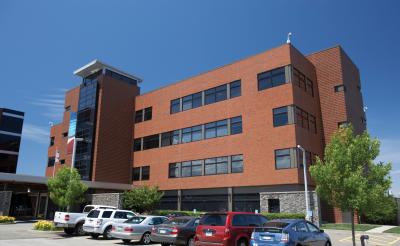UPMC Hamot Holds Community Close to Heart
Innovations in robotic heart surgery improve overall health of Erie
To have truly transformative care, UPMC Hamot is changing the traditional definition of health care. So, it's no surprise that UPMC is a trailblazer in matters of the heart.
This year, Dr. Stephen Waterford, who specializes in cardiothoracic and cardiac surgery at UPMC Hamot, is expanding health care horizons to include robotics in heart surgery. By using a robot, heart surgeries can be minimally invasive and reduce recovery time, blood loss, and possible complications.
Robotics first landed on the radar of medical professionals in the late 1990s, marking the beginning of America's first significant embrace of robotic technology in medicine. It was then that Dr. Johannes Bonatti became one of the first surgeons to perform coronary bypass surgery using robotics. "We already have a true robotic pioneer in the [UPMC] system, which is Dr. Bonatti," Waterford said.
Waterford worked alongside Bonatti throughout the past year, learning to operate via robotics on patients, especially those with atrial fibrillation (AFib) and mitral valve issues. In the time since the '90s, the interest in robotics died down, but UPMC kept its nose to the grindstone and continued its research. Now, a resurgence of interest in robotics is taking hold of the medical field nationwide, and UPMC is at the forefront.
Waterford himself has plenty of credentials. The surgeon grew up in New York City before attending Yale University for his bachelor's and master's degrees in biophysics and biochemistry. He then attended medical school at Harvard and trained at hospitals in San Francisco, Boston, and St. Louis. Before coming to UPMC Hamot in 2022, he did two extra years of training for mitral valve reconstruction at Mount Sinai Hospital under Dr. David Adams, a recognized leader in the field.
Minimally invasive heart surgery is not a new concept. It enables heart surgeons to operate with precision and not divide the breastbone like the traditional method. "The robot adds a much-improved ability to see or visualize what you're doing, and that's a big benefit when you're doing something as detailed as a mitral valve repair where it's a couple of millimeters that you need to fix," Waterford explained.
The robot is another tool in Waterford's belt, as its four arms and camera allow him to view a 3D image of the heart while operating. Traditional heart surgery requires a five to seven-day stay in the hospital for recovery, whereas the minimally invasive operation using robotics allows patients to leave the hospital in as little as two to three days.
 Dr. Stephen Waterford, a specialist in cardiothoracic and cardiac surgery at UPMC Hamot, is introducing robotics into Erie-area cardiac care, which will greatly improve outcomes for certain heart surgeries – making them minimally invasive, reducing recovery time, and minimizing blood loss and complications. (Photo: © UPMC_Creative Services 2020)
Dr. Stephen Waterford, a specialist in cardiothoracic and cardiac surgery at UPMC Hamot, is introducing robotics into Erie-area cardiac care, which will greatly improve outcomes for certain heart surgeries – making them minimally invasive, reducing recovery time, and minimizing blood loss and complications. (Photo: © UPMC_Creative Services 2020)
Mitral valve disease is not common, but it is a difficult burden for those who experience it. The mitral valve is made of two leaflets around 1 to 2 inches and has strings like a parachute that connect it to the heart's infrastructure. If there is a small break or leak — even 1 millimeter — it can cause heart problems. Instead of cutting the valve out and replacing it with a synthetic valve or a bioprosthetic valve that comes from an animal, repairing the valve increases the chance of survival and can grant its patients a longer life. Waterford explained that he employs a plastic surgery technique to rearrange the valve's pre-existing tissue to stop the leak.
UPMC is already unique in its ability to perform coronary bypass surgery thanks to Bonatti, but now, those in need of minimally invasive mitral valve repair or AFib treatment will be able to get that care at UPMC Hamot, too.
Waterford said that value resonates with him the most — UPMC's commitment to treat patients without sending them to a different hospital outside the region. "[At Hamot] they can stay where they're from and where their families can see them," Waterford said.
Using robotics will improve the accuracy of those operations, too, while increasing the volume of surgeries that Waterford and Bonatti can perform. This year, they are on track to complete 100 to 150 minimally invasive heart surgeries. Waterford works closely with UPMC Hamot's team of cardiologists and says the robust relationship benefits patients literally putting their lives in the hands of medical professionals.
In addition, Waterford said Northwest Pennsylvania is a region where the number of people with heart conditions is rapidly increasing. Fortunately, the robotic procedure remains accessible to those who prove to be viable candidates as insurance covers the cost the same as it would using traditional techniques since the robot is just another tool in the operating room.
It is through innovations like robotics training, top-of-the-line surgeons, and community initiatives that UPMC Hamot is set apart — it truly has the health of its patients at its heart.
For more information visit: upmc.com




